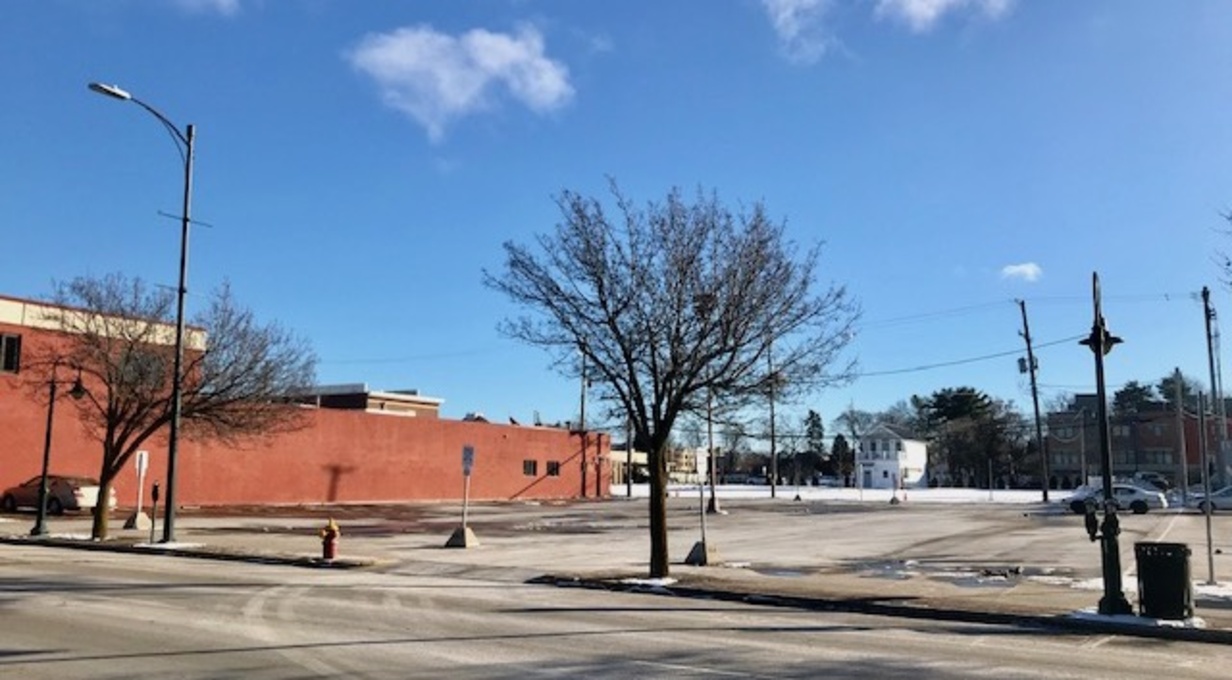
Building West End Deck Will Require Extending TIF 97, Says DDA Leader
By Beth Milligan | Jan. 14, 2019
New cost estimates for a planned third and final public parking deck in downtown Traverse City put construction between $15.6 and $19.5 million – a range higher than previously projected, and one that will require extending the city’s tax increment financing (TIF) 97 plan to fund the project, according to downtown leadership.
Traverse City Downtown Development Authority (DDA) CEO Jean Derenzy will appear before DDA board members and Traverse City commissioners in a joint 7pm meeting tonight (Monday) at the Governmental Center to discuss plans for the new deck and extending TIF 97. The city has long planned to build a west-side public parking deck that would bring several hundred new parking spaces to downtown. In 2016, the city purchased property at 145 West Front Street for $1.3 million as the intended site for the garage (pictured). Early projections estimated the project could cost $12.4 million, but newer, more detailed design options provided by consulting firm Rich & Associates project significantly higher costs.
The first and most expensive option for the deck is a $19.5 million design that would provide 566 parking spaces, with a second option proposing a 496-space garage at $17.4 million. A third option would offer 458 spaces at $15.6 million. The three options have varying setbacks at the 45-foot level – ranging from none to some, which would affect how imposing the garage feels from the street level – and options for potential commercial uses on the site.
All three options also show the deck being built to 80 feet tall. A structure that high would trigger a required public vote under city charter amendment Proposal 3. Anticipating potential debate over the height, Derenzy emphasizes that the final deck design remains an open question and that tonight’s discussion will focus on funding options, not building height or design. That conversation will come later, she says.
“We know what the numbers are – we don’t know what the height will be,” she says. “(Tonight’s discussion) is about having the ability to build a public parking garage and eliminate surface parking lots, which will provide more economic drivers for that area.” Derenzy says the main goal of tonight's meeting is to solicit feedback from DDA board members and city commissioners on the possibility of extending TIF 97 to pay for the project.
TIF 97 is one of two tax increment financing districts downtown that capture taxes on increasing property values and use those funds to pay for public improvement projects. TIF 97 covers the main part of downtown, including Front Street and the Warehouse District, while TIF 2 covers Old Town, River’s Edge, and Midtown. TIF 97 is a 30-year plan that launched in 1997 and is set to expire at the end of 2027.
That looming eight-year deadline does not provide enough time to fund the construction of a West Front Street deck using TIF dollars to repay the bond debt – the funding mechanism that was used to build both the Larry C. Hardy and Old Town parking decks. The 540-space Hardy deck between Front and State streets cost $8.3 million to build and opened in 2003, while the 522-space Old Town deck between Eighth Street and Lake Avenue cost $7.5 million and opened in 2010. Old Town was financed through TIF 2; Hardy was financed through TIF 97 and is scheduled to be paid off by the time the plan expires in 2027. TIF 97 brings in approximately $2 million annually, $1 million of which goes toward the Hardy bond debt, according to Derenzy.
“Public infrastructure of this nature typically needs 20 to 25 years (to pay off), like the Hardy parking deck,” Derenzy wrote in a memo to city leaders. “The extension of TIF 97 for an additional 20 years is necessary if we are to realize a west end parking structure utilizing TIF.”
Derenzy says other potential funding sources – from raising parking fees to using general fund dollars to securing private investment – are either “impossible” to do at a scale that would pay for the deck or would require a complete change in project scope, such as having a private instead of public deck. She sees extending TIF 97 as the city’s only realistic option for building the deck as city leaders have envisioned it. There are also numerous other high-profile projects on the horizon for the DDA that could be at least partially funded by extending TIF 97, including a redesign of the Sara Hardy Farmers Market, the construction of a new civic square, projects to improve public access and recreation on the lower Boardman River, and streetscape, alley, and tree planting initiatives. “All of those projects are important for the health and vitality of downtown,” Derenzy says.
City leaders approved extending downtown’s other tax increment financing plan, TIF 2, when it expired in 2016. However, in that district, leaders “reset” the plan. TIF districts freeze the taxable values of all the parcels in their boundaries in the year they’re launched – ie, at the 1997 rates for the TIF 97 district – and then capture taxes on the difference between those base rates and the actual increasing property values each year over the lifespan of the plan. When agreeing to extend TIF 2 for another 25 years, leaders “reset” or brought the base rates up to today’s property values. The reset provided a boost in revenues to local taxing jurisdictions whose funds were being captured - organizations like Northwestern Michigan College, Bay Area Transportation Authority, and Traverse Area District Library - but has also meant a slower trickle of funding to the TIF 2 account, since the tax capture started over. For TIF 97, Derenzy is proposing only extending the plan, not resetting it – a reset would not generate enough tax capture to pay for the deck, she says.
Extending TIF 97 would only require the approval of DDA board members and city commissioners – not the taxing jurisdictions affected by the plan. But Derenzy says she still plans to meet with those agencies to gather their input. She points to projects that have sprung up around public parking decks – such as Hagerty’s expansion, Ivy Terrace, and Old Town Corner by the Old Town deck and 101 North Park, Radio Centre III, and the Park Place conference center by the Hardy deck – as providing new jobs and economic growth that benefit the entire community. She says a West Front deck will provide similar growth opportunities for that end of downtown, and that the sooner the city finalizes a funding plan for the project, the sooner the structure can be built.
“We realized that economic benefit at the Hardy and Old Town decks, and we will realize it on the west end,” she says. “But we can’t realize it without extending TIF 97.”
Comment






